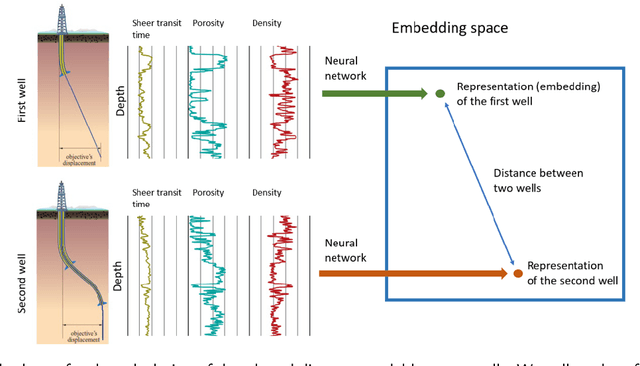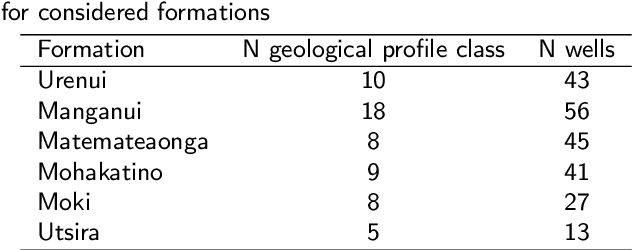Nikolay Stulov
Similarity learning for wells based on logging data
Feb 11, 2022



Abstract:One of the first steps during the investigation of geological objects is the interwell correlation. It provides information on the structure of the objects under study, as it comprises the framework for constructing geological models and assessing hydrocarbon reserves. Today, the detailed interwell correlation relies on manual analysis of well-logging data. Thus, it is time-consuming and of a subjective nature. The essence of the interwell correlation constitutes an assessment of the similarities between geological profiles. There were many attempts to automate the process of interwell correlation by means of rule-based approaches, classic machine learning approaches, and deep learning approaches in the past. However, most approaches are of limited usage and inherent subjectivity of experts. We propose a novel framework to solve the geological profile similarity estimation based on a deep learning model. Our similarity model takes well-logging data as input and provides the similarity of wells as output. The developed framework enables (1) extracting patterns and essential characteristics of geological profiles within the wells and (2) model training following the unsupervised paradigm without the need for manual analysis and interpretation of well-logging data. For model testing, we used two open datasets originating in New Zealand and Norway. Our data-based similarity models provide high performance: the accuracy of our model is $0.926$ compared to $0.787$ for baselines based on the popular gradient boosting approach. With them, an oil\&gas practitioner can improve interwell correlation quality and reduce operation time.
Neural Particle Image Velocimetry
Jan 28, 2021



Abstract:In the past decades, great progress has been made in the field of optical and particle-based measurement techniques for experimental analysis of fluid flows. Particle Image Velocimetry (PIV) technique is widely used to identify flow parameters from time-consecutive snapshots of particles injected into the fluid. The computation is performed as post-processing of the experimental data via proximity measure between particles in frames of reference. However, the post-processing step becomes problematic as the motility and density of the particles increases, since the data emerges in extreme rates and volumes. Moreover, existing algorithms for PIV either provide sparse estimations of the flow or require large computational time frame preventing from on-line use. The goal of this manuscript is therefore to develop an accurate on-line algorithm for estimation of the fine-grained velocity field from PIV data. As the data constitutes a pair of images, we employ computer vision methods to solve the problem. In this work, we introduce a convolutional neural network adapted to the problem, namely Volumetric Correspondence Network (VCN) which was recently proposed for the end-to-end optical flow estimation in computer vision. The network is thoroughly trained and tested on a dataset containing both synthetic and real flow data. Experimental results are analyzed and compared to that of conventional methods as well as other recently introduced methods based on neural networks. Our analysis indicates that the proposed approach provides improved efficiency also keeping accuracy on par with other state-of-the-art methods in the field. We also verify through a-posteriori tests that our newly constructed VCN schemes are reproducing well physically relevant statistics of velocity and velocity gradients.
Learning a Generator Model from Terminal Bus Data
Jan 03, 2019



Abstract:In this work we investigate approaches to reconstruct generator models from measurements available at the generator terminal bus using machine learning (ML) techniques. The goal is to develop an emulator which is trained online and is capable of fast predictive computations. The training is illustrated on synthetic data generated based on available open-source dynamical generator model. Two ML techniques were developed and tested: (a) standard vector auto-regressive (VAR) model; and (b) novel customized long short-term memory (LSTM) deep learning model. Trade-offs in reconstruction ability between computationally light but linear AR model and powerful but computationally demanding LSTM model are established and analyzed.
 Add to Chrome
Add to Chrome Add to Firefox
Add to Firefox Add to Edge
Add to Edge